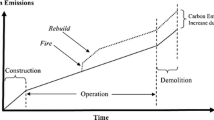Abstract
The National Fire Protection Association (NFPA) periodically updates each fire safety code and standard that it develops. Acknowledging the need for a document to prescribe fire safety for historic buildings, a complete and thorough rewrite of NFPA 914 was undertaken. The former recommended practice has now been issued as the Code for Fire Protection in Historic Structures. The 2001 edition identifies a process for analyzing fire safety needs in historic buildings, outlines generic approaches to dealing with specific provisions of other codes that may endanger historic integrity, and includes a performance-based approach to fire safety in historic buildings. This paper describes the background, revision process, and current proposed content NFPA 914.
Similar content being viewed by others
References
ISO/DTR 13387–1, “Fire Safety Engineering-Part 1: The Application of Fire Performance Concepts to Design Objectives,” International Organization for Standardization, ISO Technical Committee/Subcommittee: TC 92/SC 4, 1998.
Windsor-The Great Fire, Andover, Hants, UK, Pitkin Pictorials, 1992.
Sir A. Bailey, D. Insall, and P. Kilshaw, Fire Protection Measures for Royal Palaces, London, Department of National Heritage, 1993.
Society of Fire Protection Engineers, SFPE Today, November-December 1999, p. 4.
H.L. Malholtra, and K. Papaioannou, “Framework for a CIB Guide on Fire Safety for Historic Buildings,” Fire Science and Technology, vol. 11, no.1, 2, 1991, pp. 69–72.
I. Maxwell, N. Ross, and A. Dakin, eds., Fire Protection and the Built Heritage: Conference Abstracts, Edinburgh, Technical Conservation Research and Education Division, Historic Scotland, 1998.
J. Fangrat, in Proceedings, Third International Symposium on Fire Protection of Heritage, 6–9 October 1999, Poland.
K. Papaioannou, ed., Proceedings, International Conference on Fire Protection of Cultural Heritage, Thessaloniki, Greece, University of Aristotle, 1–2 June 2000.
J.M. Watts, Jr., “Rehabilitating Existing Buildings,” Fire Protection Engineering, Spring 1999, pp. 6–8, 10, 12, 14, 15.
“Fire Protection Measures in Scottish Historic Buildings,” Technical Advice Note No. 11, Edinburgh, Technical Conservation, Research, and Education Division, Historic Scotland, 1997.
C. Caldwell, and H. MacLennan, “Guidelines for Fire Safety,” No. 7, Wellington, New Zealand Historic Places Trust, 2000.
J.M. Watts, Jr. and M.E. Kaplan, “Performance-Based Approach to Protecting Our Heritage,” in Proceedings: International Conference on Performance-Based Codes and Fire Safety Design Methods, Boston, Society of Fire Protection Engineers, 1997, pp. 339–347.
“Burra Charter,” Sydney, New South Wales, Australia, International Center for the Conservation and Restoration of Monuments and Sites (ICOMOS), 1992.
“Charter of Venice: International Charter for the Conservation and Restoration of Monuments and Sites,” Venice, Italy, Second International Congress of the Architects and Technicians of Historic Monuments, 1964.
“The Secretary of the Interior's Standards for Rehabilitation and Guidelines for Rehabilitating Historic Buildings,” Washington, DC, National Park Service, U.S. Department of the Interior, 1993.
M.E. Kaplan, and J.M. Watts, Jr., “Draft Code for Historic Buildings,” Williamsburg, VA, Association for Preservation Technology International, October 2000.
R. Lewis, “NFPA Committee on Cultural Resources-The First 50 Years,” unpublished document.
NFPA 914, Code for Fire Protection of Historic Structures, Quincy, MA, National Fire Protection Association, 2001.
NFPA 101, Life Safety Code, Quincy MA, National Fire Protection Association, 2000.
J.M. Watts, Jr., “Fire Risk Indexing, Section 5, Chapter 10, in SFPE Handbook of Fire Protection Engineering, 3rd ed., Quincy, MA, National Fire Protection Association, 2001.
J.M. Watts, Jr. and M.E. Kaplan, “Fire Risk Index for Historic Buildings,” Fire Technology, vol. 36, no.2, 2001, pp. 167–180.
J.M. Watts, Jr., “Performance-Based Fire Safety Codes for Heritage Buildings,” Lund, Sweden, Third International Conference on Performance-Based Codes and Fire Safety Design Methods, 15–17 June 2000.
Author information
Authors and Affiliations
Rights and permissions
About this article
Cite this article
Watts, J.M., Solomon, R.E. Fire Safety Code for Historic Structures. Fire Technology 38, 301–310 (2002). https://doi.org/10.1023/A:1020110214065
Issue Date:
DOI: https://doi.org/10.1023/A:1020110214065




